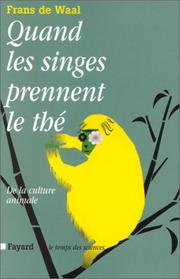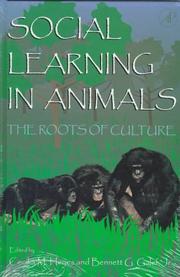| Listing 1 - 10 of 44 | << page >> |
Sort by
|
Book
Year: 1933 Publisher: Paris : Armand Colin,
Abstract | Keywords | Export | Availability | Bookmark
 Loading...
Loading...Choose an application
- Reference Manager
- EndNote
- RefWorks (Direct export to RefWorks)

ISBN: 2213609233 9782213609232 Year: 2001 Publisher: Paris : Fayard,
Abstract | Keywords | Export | Availability | Bookmark
 Loading...
Loading...Choose an application
- Reference Manager
- EndNote
- RefWorks (Direct export to RefWorks)
Hominidés --- Singes --- Primates --- Comportement social des animaux --- Moeurs et comportement

ISBN: 2227137096 9782227137097 Year: 1997 Publisher: Paris: Bayard,
Abstract | Keywords | Export | Availability | Bookmark
 Loading...
Loading...Choose an application
- Reference Manager
- EndNote
- RefWorks (Direct export to RefWorks)
La moralité caractérise-t-elle seulement les êtres humains ? Après tout, les animaux aussi ont des règles sociales d'entraide et de partage, des modes de régulation des conflits, un sens de la justice et de l'équité... Faisant le point des données naturelles, en particulier des observations recueillies chez certaines espèces proches de nous, comme les singes, mais aussi chez les mammifères marins ou les chiens, Frans de Waal apporte une contribution particulièrement originale et féconde au débat sur les sources, les fondements et la nature de la morale. Et si les animaux avaient aussi une morale ? Et si la moralité était un produit de l'évolution biologique ?
Singes --- Primates --- Comportement social des animaux --- Moeurs et comportement
Book
Year: 1905 Publisher: Paris : Vuibert et Nony,
Abstract | Keywords | Export | Availability | Bookmark
 Loading...
Loading...Choose an application
- Reference Manager
- EndNote
- RefWorks (Direct export to RefWorks)
Animaux bâtisseurs. --- Comportement social des animaux. --- Comportement animal.
Book
Year: 1969 Publisher: Bruxelles : Dessart,
Abstract | Keywords | Export | Availability | Bookmark
 Loading...
Loading...Choose an application
- Reference Manager
- EndNote
- RefWorks (Direct export to RefWorks)
Ethnologie --- Animaux --- Comportement social des animaux --- Moeurs et comportement --- Ethnologie --- Animaux --- Comportement social des animaux --- Moeurs et comportement
Book
ISBN: 2282300378 Year: 2004 Publisher: Paris : Denoël,
Abstract | Keywords | Export | Availability | Bookmark
 Loading...
Loading...Choose an application
- Reference Manager
- EndNote
- RefWorks (Direct export to RefWorks)
Comportement social des animaux --- --Mondes parallèles --- Psychologie comparée --- Animaux --- Comportement humain --- Moeurs et comportement --- Comportement social des animaux --- --Mondes parallèles --- Psychologie comparée --- Animaux --- Comportement humain --- Moeurs et comportement
Book

ISBN: 9791035107000 Year: 2021 Publisher: Paris : Éditions de la Sorbonne,
Abstract | Keywords | Export | Availability | Bookmark
 Loading...
Loading...Choose an application
- Reference Manager
- EndNote
- RefWorks (Direct export to RefWorks)
Plus aucune science ne peut penser les animaux à elle seule, ni prétendre pouvoir faire le tour de la question : pour mieux lire les animaux, il faut croiser les sciences. C’est devenu une évidence entre les différentes sciences de la nature, où des croisements ont déjà donné naissance à des hybrides devenus disciplines à part entière, telle l’écologie comportementale ; c’est aussi vrai entre les sciences humaines, qui ont investi, depuis quelques décennies, le versant humain des relations avec les animaux. Cet ouvrage propose un troisième croisement, novateur, difficile, car peu pensé, peu usité, entre les sciences dites « de la nature » et les sciences dites « humaines ». Il s’agit de montrer que les questions, les concepts et les méthodes de ces dernières peuvent apporter beaucoup à la connaissance des animaux eux-mêmes, à l’étude de leurs capacités qui sont de plus en plus reconnues comme étant riches et complexes. Il y a profit – et donc un besoin – à croiser les sciences de la vie – génétique, physiologie, éthologie, écologie, neurosciences – avec les sciences de l’homme – archéozoologie, histoire de l’art, histoire, littérature, anthropologie, sociologie, ethnologie – pour décrypter, saisir et penser davantage les animaux – en somme, passer sur le versant animal. Rassemblant des spécialistes de ces disciplines, ce livre s’adresse aux archéologues, aux historiens, aux géographes, aux littéraires, aux anthropologues, aux sociologues, aux philosophes, comme aux généticiens, aux zoologues, aux éthologues, aux écologues, aux vétérinaires. Et aux passionnés d’animaux.
Social Sciences, Interdisciplinary --- animaux --- comportement social des animaux --- histoire animale

ISBN: 9780080541310 0080541313 9780122739651 0122739655 Year: 1996 Publisher: San Diego Academic Press
Abstract | Keywords | Export | Availability | Bookmark
 Loading...
Loading...Choose an application
- Reference Manager
- EndNote
- RefWorks (Direct export to RefWorks)
The increasing realization among behaviorists and psychologists is that many animals learn by observation as members of social systems. Such settings contribute to the formation of culture. This book combines the knowledge of two groups of scientists with different backgrounds to establish a working consensus for future research. The book is divided into two major sections, with contributions by a well-known, international, and interdisciplinary team which integrates these growing areas of inquiry.
Animal psychology and neurophysiology --- Zoology --- Apprentissage chez les animaux --- Comportement social des animaux --- Imitation
Book
ISBN: 9782840162728 Year: 2017 Publisher: Paris : Presses universitaires de Paris Nanterre,
Abstract | Keywords | Export | Availability | Bookmark
 Loading...
Loading...Choose an application
- Reference Manager
- EndNote
- RefWorks (Direct export to RefWorks)
Relations homme-animal. --- Écologie humaine. --- Animaux --- Comportement social des animaux --- Droits. --- Sociologie.
Book
ISBN: 9780198849834 Year: 2020 Publisher: Oxford, United Kingdom : Oxford University Press,
Abstract | Keywords | Export | Availability | Bookmark
 Loading...
Loading...Choose an application
- Reference Manager
- EndNote
- RefWorks (Direct export to RefWorks)
"In social animals, perturbations may trigger specific behavioural responses with consequences for dispersal and complex population dynamics. Perturbations raise the need for information gathering in order to reduce uncertainty and increase resilience. Updated information is then shared within the group and social behaviours emerge as a self-organized process. This social information factoralizes with the size of the group, and it is finally used for making crucial decisions about, for instance, when to leave the patch and where to go. Indeed, evolution has favoured philopatry over dispersal, and this trade-off is challenged by perturbations. When perturbations accumulate over time, they may decrease the suitability of the patch and erode the philopatric state until crossing a tipping point, beyond which most individuals decide to disperse to better areas. Initially, the decision to disperse is led by a few individuals, and this decision is copied by the rest of the group in an autocatalytic way. This feedback process of social copying is termed runaway dispersal. Furthermore, social copying enhances the evolution of cultural and technological innovation, which may cause additional non-linearities for population dynamics. Social information gathering and social copying have also occurred in human evolution, especially after perturbations such as climate extremes and warfare. In summary, social feedback processes cause non-linear population dynamics including hysteresis and critical transitions (from philopatry to patch collapses and invasions), which emerge from the collective behaviour of large ensembles of individuals"--
Population biology. --- Animal populations --- Social behavior in animals. --- Biologie des populations --- Animaux --- Comportement social des animaux
| Listing 1 - 10 of 44 | << page >> |
Sort by
|

 Search
Search Feedback
Feedback About UniCat
About UniCat  Help
Help News
News